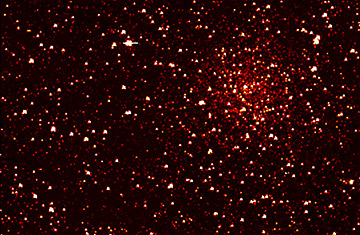
A cluster of stars appear in a small portion of Kepler's full field of view of the Milky Way
In the two years since it went into space, the Kepler satellite has revolutionized the search for planets around other stars. Before Kepler went into space, about 500 so-called exoplanets had been found, one by painstaking one over the course of more than a decade. Since then, Kepler has added another 1,200, and that's just a fraction of the planets the probe will ultimately discover. (To be technical, the bodies Kepler finds are known as "candidate planets" that need confirmation, but no one doubts that the vast majority of them are real.)
One reason Kepler has been so wildly successful is that it stares at a huge number of stars — some 150,000 of them, around the clock — looking for tiny dips of light. That change in luminescence indicates that a planet is passing in front of the star. No human could possibly sort through all that data, so the Kepler team has created a kind of sifter software that looks for patterns hinting at orbiting planets.
But while computers are terrific at high-volume data-processing, nothing beats the human eye for pattern-recognition — which is why a project dreamed up by Yale University astronomer Debra Fischer, a veteran planet hunter and Kepler project scientist, has turned out to be so extraordinarily useful. Called Planethunters.org, it lets ordinary folks with no scientific training at all help find planets the Kepler software has missed. It works so well that in just a few short months of operation, the more than 22,000 visitors to the website have found nearly 50 potential planets, which are being sent on to Kepler headquarters at the NASA Ames Research Center in California for followup.
You might think the planethunters team would require people who click on the site to undergo a fair amount of online training before allowing them to look at real data — but you'd be wrong. "We've got all sorts of online tutorials which explain the science," says Fischer. "But people don't have to look at them, and most don't."
Instead, you can cut straight to the real stuff : a simple explanation of what you're supposed to look for (a series of regular dips in a given star's "lightcurve," which is just a graph of its brightness over time) and how use an onscreen box to mark any suspicious spots. That's pretty much it — except that the last screen asks: "Logged in users get to see the best stars and get credit for their work. Would you like to login?" Think many folks say no?
Once they start looking, says Fischer, some people stay only a short while, but others hang in, looking for dips and answering simple online questions about them. "We have people doing 100 [stars], 5,000 — the users created their own 5,000 club — and even 20,000." No one sighting qualifies as a likely detection, but if enough users finger the same star, the scientists take notice.
"It really is the wisdom of the crowd," says Meg Schwamb, a Yale postdoctoral fellow who serves as the lead project scientist. When users prove unusually good at spotting potential planets, says Fischer, "we upgrade them, and weigh their opinions more heavily."
The scientists at Kepler mission headquarters, meanwhile, by no means resent contributions from the untutored masses. Quite the contrary. "It's absolutely no surprise to me that they'd find planet candidates we missed," says Natalie Batalha, Deputy Principal Investigator for the Kepler mission. Software can pick up signals the human eye and brain can't, she says, but it has to account for the fact that individual stars vary in brightness even when they don't have planets. You don't want to mistake a pulsating star for a star that dims because of a planet's shadow. "Our software does a good job of weeding out these stars, but it's not perfect," Batalha concedes.
Indeed, says astronomer Chris Lintott, currently at the Adler Planetarium in Chicago, this isn't the first time the untrained human brain has been able to help astronomers out. Back in 2007, Lintott and his grad student Kevin Schawinski were trying to catalog a million galaxies by shape. Schawinski did about 50,000, but balked at looking at the other 950,000. Together, they created something called Galaxy Zoo, which let amateurs do the identifying for them. "Recognizing patterns," says Lintott, "involves exactly the same skills we evolved to hunt and to avoid being hunted."
The project proved so successful that Lintott and Schawanski expanded into other online citizen-science projects under an umbrella they call Zooniverse. And last year, when Schawinski had moved on to Yale, he began talking with Fischer about how the search for planets might be helped by this same kind of vox pop effort.
If the scientists are happy with the help they're getting in processing their data, they're flat-out thrilled that so many outsiders are getting so excited about the science. "I get emails," says Fischer, "or see postings on our message board that say 'wow, I'm going to go back to school to learn more about astronomy,' or 'I can't believe I can get a chance to look at real data and do real planet detection!'"
Adds Batalha: "You've got kids doing this, experiencing the thrill of seeing something for the first time that nobody else has ever seen. It's just fabulous." When some of those kids can say they've helped change the very map of the cosmos, they could be hooked on science for life.
